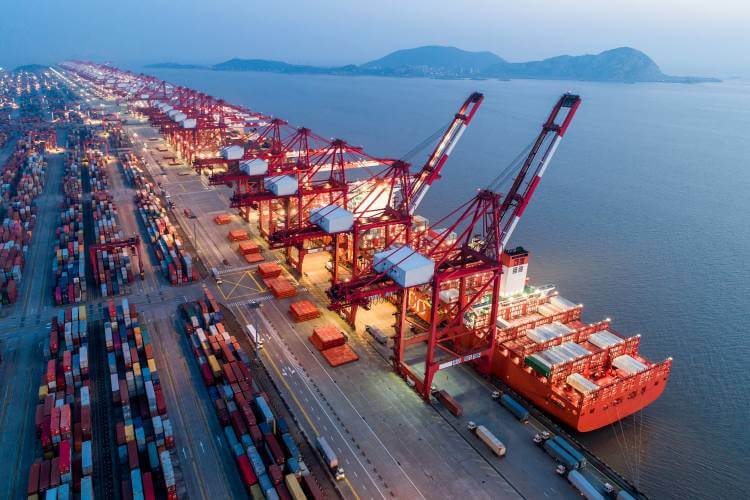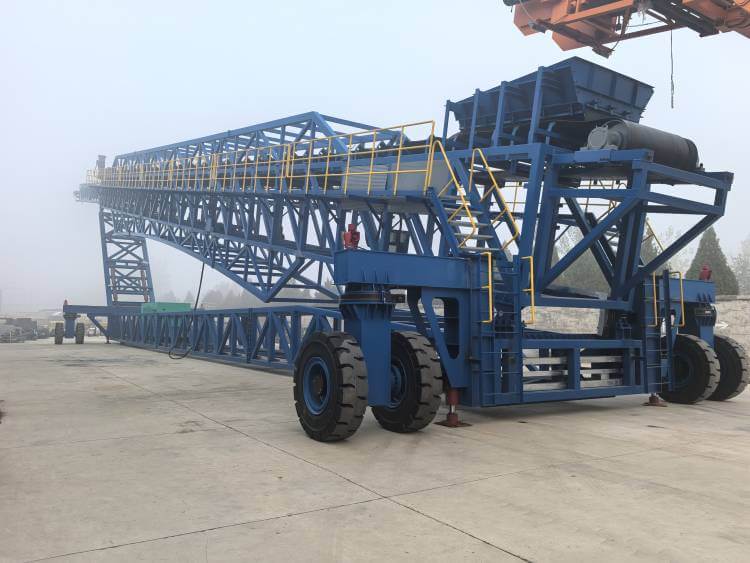Typically, fertilizer handling operations involve transporting fertilizers to ports via cargo ships, either in bagged or bulk form. During unloading, a portal crane lifts the fertilizer from the cargo ship to the bulk terminal, from where trucks or pallets transport it to the storage yard for stacking. The loading process follows the reverse procedure. If the fertilizer is in bulk form, it can be transported by train or truck. However, these methods often suffer from low efficiency, material losses, moisture absorption, caking, and contamination, leading to high overall costs and significant environmental pollution. These challenges make it difficult to meet the growing transportation demands.
In recent years, the mobile ship loader has gained attention as a new type of port handling equipment. Due to its compact size and high flexibility, it allows for rapid switching between different ship holds without being affected by terrain constraints. As one of the main devices for bulk material handling at ports, it has proven efficient. However, as more users adopt this technology, some have begun questioning its reliability in port fertilizer handling.

Working Principle of the Mobile Ship Loader
The working principle of the mobile ship loader is based on its multifunctional system. First, the equipment moves flexibly within the port via a walking system, allowing it to access different ship holds efficiently. The boom system, featuring telescopic, rotational, and pitch adjustments, ensures precise positioning within ship holds for efficient and accurate loading and unloading. The conveying system transfers materials from the dock to the ship hold using belt conveyors, bucket elevators, or screw conveyors, completing the material loading process.

Advantages of Mobile Ship Loaders in Port Fertilizer Handling
High Efficiency and Energy Savings
The Zoomry mobile ship loader adopts an efficient drive system and intelligent control technology that automatically adjusts operating speed based on load and operational demands, reducing energy consumption. With a loading capacity of up to 3,500 tons per hour, all drive systems are optimized for continuous operation, minimizing downtime. Unlike traditional handling methods that involve frequent stops, the mobile ship loader enables uninterrupted operations. Additionally, it supports rapid hatch switching, utilizing an all-wheel steering system and intelligent controls to quickly reposition between different holds. This feature is especially beneficial during peak seasonal demands, significantly shortening handling cycles and ensuring a smooth fertilizer supply chain.
Adaptability to Various Vessel Types
The mobile ship loader is equipped with five different steering modes (crab steering, radial, turntable, straight-line, and parallel movement), allowing it to navigate narrow port spaces freely. With its extendable boom, rotational, and pitch adjustment functions, the ship loader can precisely align with various vessel types, including barges, Handy, Supramax, and Panamax vessels.
Prevents Secondary Handling, Ensures Cargo Quality
As a fine bulk material, fertilizer is susceptible to spillage, moisture, and contamination during traditional handling methods that involve secondary transfers. Additionally, conventional unloading creates significant dust, polluting the air and the surrounding environment. The mobile ship loader directly receives fertilizer from storage yards or truck unloader via its conveying system. Equipped with dust control measures such as telescopic dust covers, bag filter systems, and dust extraction units, it effectively contains materials within the conveyor passage. The automatic telescopic conveyor arm precisely aligns with different loading heights and positions, ensuring uniform fertilizer loading in ship holds, reducing dust pollution and material waste. The entire process is completed in a single step, eliminating intermediate handling losses.
Please contact us using the info below if you have any questions about mobile shiploader for port fertilizer
- Zoomry official website
- +86 131-6401-6717
- oversea@zoomry.cn
High Automation, User-Friendly Operation
The mobile ship loader incorporates an intelligent control system featuring wireless remote control, automatic adjustment, and one-touch operation. This design simplifies equipment operation, making it intuitive for operators. Even personnel with minimal experience can quickly master the operation with brief training, reducing dependency on highly skilled workers. Additionally, automation minimizes human errors, lowering operational risks and training costs at ports.
Lower Costs, Higher Economic Benefits
Compared to traditional fixed unloading equipment, mobile ship loaders require lower investment and maintenance costs. Fixed loading systems often demand extensive infrastructure modifications, whereas mobile loaders do not require dedicated tracks or port renovations. This flexibility significantly reduces initial investment costs.
Additional Advantages
Versatile for Various Bulk Cargoes
The multifunctionality of mobile ship loaders makes them highly versatile for port applications. Besides fertilizers, they can handle materials such as sand, gravel, aggregates, coal, and ores. By adjusting the conveying system or operational mode, the loader can adapt to different materials, maximizing its utility and operational value.
High Scalability and Easy Functional Upgrades
As port handling demands evolve, mobile ship loaders offer strong scalability. The equipment can be upgraded with additional features to enhance efficiency and functionality. For instance, customized conveying systems can be designed to cater specifically to fertilizer handling requirements, further improving efficiency and adaptability.

Case Study
Santos Port is the largest deep-water port in South America, capable of accommodating bulk carriers ranging from 50,000 to 120,000 DWT, including barges, Handy, Supramax, Panamax, and Capesize vessels. Fertilizer is one of the primary cargoes handled at this port, with future expansion plans to include other bulk materials such as grains and iron ore.
To meet these demands, the Santos Port Authority sought high-quality mobile ship loading equipment suppliers and ultimately connected with Zoomry Heavy Industry Co., Ltd., located in Hebei, China. This high-tech enterprise specializes in the development and manufacturing of bulk material conveying equipment, including mobile ship loaders, telescopic loaders, radial ship loaders, mobile stackers, truck unloaders, and portable conveyors. Zoomry also provides complete conveying systems, such as long-distance overland belt conveyors and tubular belt conveyors.
Zoomry has extensive experience in manufacturing mobile ship loaders and has deeply engaged in the bulk material handling industry. It independently produces high-quality, long-life idlers and rollers. Its heavy-duty trough idlers have a lifespan exceeding 50,000 hours. The company operates independent production lines, supplying premium Conveyor Belt idlers made from seamless steel pipes, featuring low radial runout, excellent roundness, low noise, and superior wear resistance.
Since 2018, leveraging its strong engineering team and conveyor design expertise, Zoomry has introduced mobile ship loaders, telescopic loaders, radial loaders, mobile stackers, telescopic stackers, radial stackers, crawler stackers, fully hydraulic ship loaders, fully hydraulic stackers, and truck unloaders. The mobile ship loader consists primarily of a conveying system and an engineering machinery chassis. The conveying system benefits from over 20 years of expertise, while the chassis is optimized based on Zoomry’s understanding of port loading equipment and China’s robust engineering machinery capabilities. Currently, Zoomry's mobile ship loaders have evolved into their fourth generation, featuring enhanced mobility, flexibility, and durability.
Zoomry offers three types of mobile ship loaders: crawler-mounted, non-self-propelled tire-mounted, and fully hydraulic self-propelled tire-mounted. The crawler-mounted model, also known as a crawler-driven type, utilizes an excavator chassis from China’s renowned SANY Heavy Industry, allowing it to operate in challenging terrains and tight port spaces. It supports forward/reverse movement, linear motion, vertical adjustments, and radial rotation, significantly improving loading efficiency. Additionally, to accommodate various port requirements, Zoomry has introduced a fully hydraulic tire-mounted ship loader, which also supports forward/reverse movement, linear travel, vertical adjustments, and radial rotation.
Subsequently, engineers and project managers from Santos Port visited Zoomry for an on-site assessment of the mobile ship loader's operational performance. Impressed by the equipment's high quality and exceptional capabilities, they expressed strong confidence in future cooperation.

 ZOOMRY
ZOOMRY

